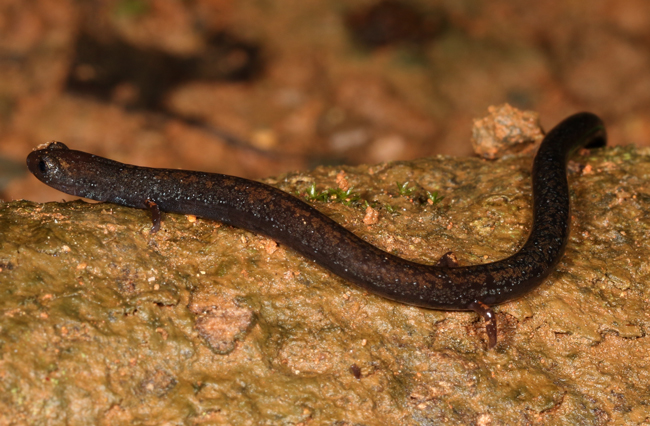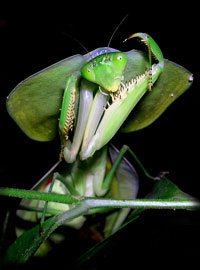|
Discover the
hidden treasures of Drake Bay, Costa Rica with Tracie "The Bug Lady" .

Home

Tour
Basics

Meet the Bug
Lady

Tales from the
Edge

Media

Reservations

Links



Facts about Drake Bay, Costa Rica

Travel To Drake Bay

Drake Bay Area Map

Hotel Information

Tips for Travelers

Tours

Recommended
Reading





|
|
|

Allen's Worm Salamander
-
Oedipina alleni |
Although rare to see, salamanders inhabit the rainforest undergrowth
of Costa Rica's Osa Peninsula. They are very easily distinguished from all other amphibians
by their long tail. Despite the very rich variety of frog
families represented in Costa Rica, there is only one salamander
family: Plethodontidae. Plethodontidae is the world's largest
salamander family containing about 240 species. This is about 60
percent of all known salamanders.
Fifty-three species have been recorded in Costa Rica so far and diversity
is greatest in the highlands. In January 2008 three species of
salamander new to science were discovered in La Amistad
International Park. La Amistad is Costa Rica's largest National Park
and is also a UNESCO World Heritage Site. Four species of salamander
are known from the Osa Peninsula, three of which are
present in Drake Bay and featured on this page.
|
|
Oedipina alleni and Oedipina pacificensis, are know as worm salamanders. Why they are called worm salamanders
is strikingly obvious when looking at one. With their very narrow
build, long tail, tiny legs and feet, these salamanders resemble
earthworms at first glance. They also quickly squirm for cover
like little worms when startled.

Allen's Worm
Salamander - Oedipina alleni
Finding
these exceptional creatures on the Night Tour is always a very lucky
encounter. They spend most of their lives on the forest floor
underneath the leaf litter or hiding under logs and rocks. Given
their small size and cryptic coloration, a run in with a salamander
is always an exciting and uncommon event. It seems they are more easily
encountered moving about in the open during or after a heavy rain.
Salamanders
are an extraordinary group. Worldwide, there are many variations in
their lifestyles, reproductive habits, and development. Most
salamanders inhabit the Northern Hemisphere with only a handful of
species drifting south of the Equator. On this page, we will
concentrate solely on Costa Rican salamanders.
All Costa
Rican salamanders are lungless and gas exchange is believed to take
place through their very thin skin membrane, as well as mucous
membranes in the mouth and throat. Also, Costa Rican
Salamanders have interesting receptors called nasolabial
grooves. These little grooves run from the salamander's nostril to
their upper lip and are believed to pick up chemical cues from their
surroundings. A salamander may use this "sixth sense" in order to
find a mate, avoid predators, or locate food.

Allen's Worm Salamander
- Oedipina alleni
|
|
Another weapon Costa Rican Salamanders employ while hunting is their
very long projectile tongue. In some species the tongue may measure
up to 80 percent of the salamander's body length and its tip is
designed for gripping, almost like a hand. It only takes
about ten milliseconds for salamanders to shoot their tongue out and
snatch their unsuspecting prey!
When not in use, the tongue is rolled up and stored in the same cavity where the salamanders originally
kept their lungs, which they have lost through evolution. Worm
salamander's tiny legs and feet are another feature believed to have
been brought about by evolution, to enhance their fossorial lifestyle.
|
|
Oedipina alleni and Oedipina pacificensis,
are closely related. Adults normally measure between 108 and 175
millimeters, with Oedipina pacificensis being slightly longer.

Pacific Worm Salamander -
Oedipina pacificensis
Salamanders are extremely long lived and in Costa Rica some have lived as long as 20 years. In one
study group, males did not even reach sexual maturity until they
were six years old and females at twelve years of age! This is
remarkable for such small, delicate animals.
Most
species of lungless salamanders are able to breed within six months
to three and a half years of hatching.
During breeding season, male salamanders go through
complex courtship rituals to attract females. Male salamanders don't call
in an attempt to attract a mate, so courtship is a proactive venture.
This may include pursuit of the female,
ritualistic dances, and caressing. Each
species of salamander has its own unique mating dance.
Male
salamanders also make a small incision on the female's skin where
they rub the females with their "mental gland". This gland is located
underneath the male's chin and secretes pheromones designed to
entice her to mate. Once
she has been induced to mate, the male lays his cone-shaped
sperm packet, called a spermatophore, on the ground and she picks it up with her cloaca.
|
|

Pacific Worm
Salamander - Oedipina
pacificensis
Females can store this sperm packet internally for up to two months.
When she decides to lay her eggs they will be fertilized internally, as they
leave the cloaca. Generally, females lay between 9 and 37 eggs
individually in a moist area on the ground. In some species the
mother curls around the eggs and guards her offspring. Parental
care has never been recorded among the two Worm Salamanders pictured here.
With every Costa Rican
salamander, all of the larval development takes place inside the
egg and the little salamander that hatches out is a miniature
version of the adult. No metamorphosis takes place after hatching.
Costa Rican salamanders are fully terrestrial and don't ever have an
aquatic phase. |
|
But
perhaps their most incredible attribute is their ability for
regeneration. As with many lizards, salamanders drop their tail
when gripped by it in order to escape a predator. Unlike
lizards, though, some salamanders regenerate their tail complete with all
its vertebrae!
Still not fully understood
by science, this amazing skill is
currently under heavy scrutiny by researchers. If
one day scientists are able to solve this puzzle, could that mean a
cure for severe spinal injuries in humans?
Oedipina alleni and Oedipina pacificensis are only known from
southwestern Costa Rica and adjoining western Panama.

Camron Climbing Salamander - Bolitoglossa lignicolor
The only other salamander species known from Drake Bay is Camron
Climbing Salamander (Bolitoglossa lignicolor).
With 137 species belonging to this genus, Bolitoglossa is the largest salamander genus on earth. Every species in this
genus occurs in the neotropics. They are called
Webfoot Salamanders, due to their extensive toe webbing. The toe
webbing, along with their prehensile tail, is an adaptation to
climbing and clinging to
wet leaves.clinging to
wet leaves.
Like Worm Salamanders, Webfoot Salamanders lay their eggs in
moist areas and go through direct development in the egg, with no
aquatic stage. Parental care of the eggs has been observed with some
species. |
|
References:
Janzen, D. 1983 Costa Rican Natural History
University of Chicago Press
Leenders, T.
2001 A Guide to Amphibians and Reptiles of Costa Rica
Zona Tropical
Leenders, T.
2016 Amphibians of Costa Rica
Zona Tropical
Savage, J. 2002 The Amphibians and Reptiles of
Costa Rica University of Chicago Press
Weldon Owen Pty
Limited 1993 Encyclopedia of Animals Barnes &
Nobles Books
|

|
|
|
|
The Frog
Files





     






 |



 Alien Earthlings
Alien Earthlings  The
Dark Side
The
Dark Side 


















